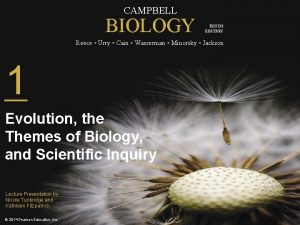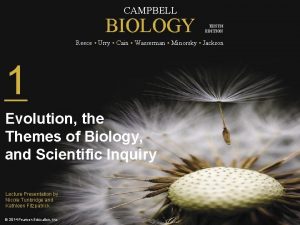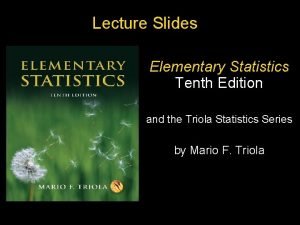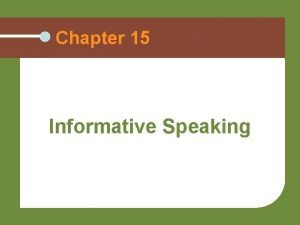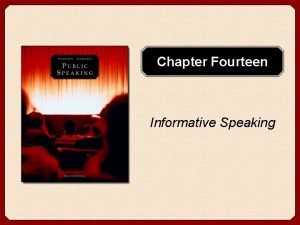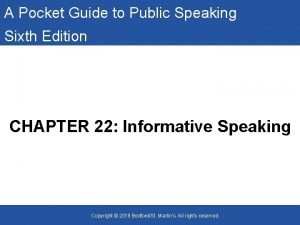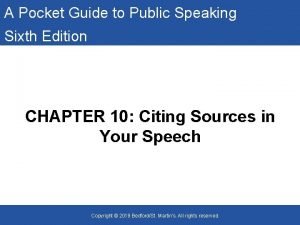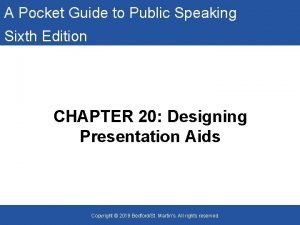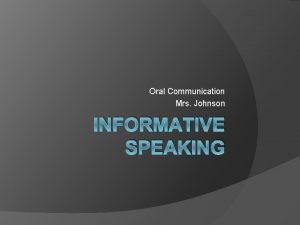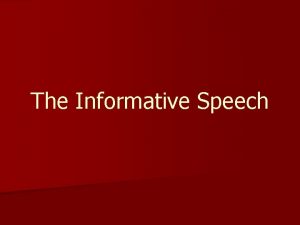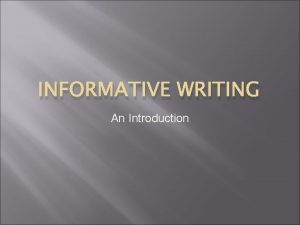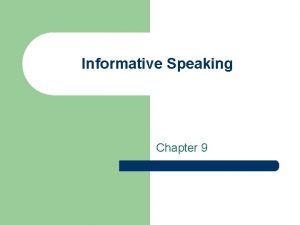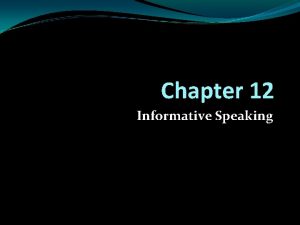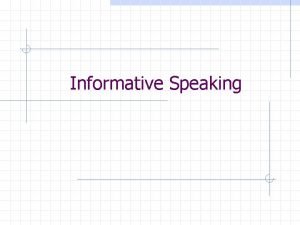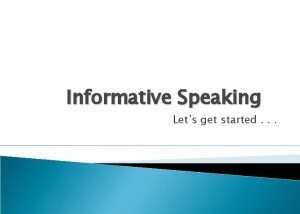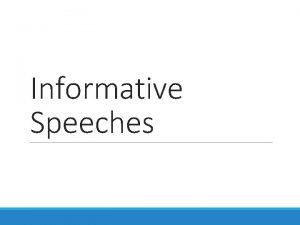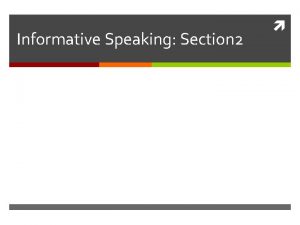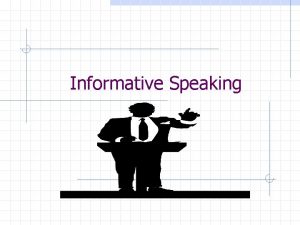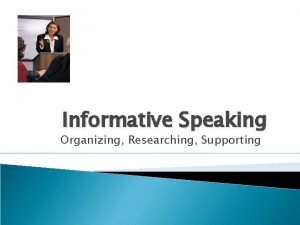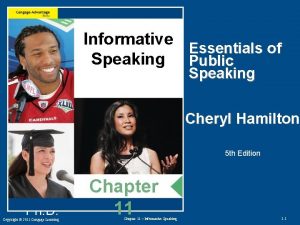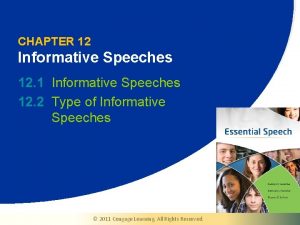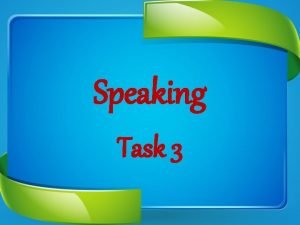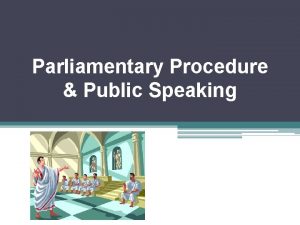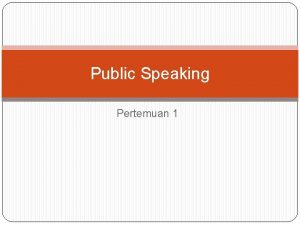Communication Tenth Edition Chapter 11 Informative Speaking Copyright























- Slides: 23

Communication Tenth Edition Chapter 11 Informative Speaking Copyright © 2017, 2014, 2011 Pearson Education, Inc. All Rights Reserved

Learning Objectives 11. 1 Recognize that information is powerful. 11. 2 Explain the distinctions between informative and persuasive speeches. 11. 3 Choose appropriate topics for your informative speeches. 11. 4 Prepare and develop an informative speech to meet your professor’s specific criteria. 11. 5 Evaluate and assess your own speeches prior to classroom presentation and apply evaluation criteria to the speeches of others. Copyright © 2017, 2014, 2011 Pearson Education, Inc. All Rights Reserved

Information and Power (1 of 2) Learning Objective 11. 1: Recognize that information is powerful. Copyright © 2017, 2014, 2011 Pearson Education, Inc. All Rights Reserved

Information and Power (2 of 2) • The greater one’s desire is to gain important information, the more valuable that information. • Thus, people who have information you desire have power over you because they have what you seek. • Social media has made information easily available to all who quickly seek it out. • The ability to communicate information is essential in our society and has an increasingly important role, not only now but in the future. Copyright © 2017, 2014, 2011 Pearson Education, Inc. All Rights Reserved

Distinctions Between Informative and Persuasive Speaking (1 of 2) Learning Objective 11. 2: Explain the distinctions between informative and persuasive speeches. Copyright © 2017, 2014, 2011 Pearson Education, Inc. All Rights Reserved

Distinctions Between Informative and Persuasive Speaking (2 of 2) • The general goal of informative speakers is to increase their listeners’ knowledge. • The persuasive speech is meant to alter attitudes and behavior. • Although information may contain elements of persuasion, all persuasion must provide information. Copyright © 2017, 2014, 2011 Pearson Education, Inc. All Rights Reserved

Topics for Informative Speeches (1 of 3) Learning Objective 11. 3: Choose appropriate topics for your informative speeches. Copyright © 2017, 2014, 2011 Pearson Education, Inc. All Rights Reserved

Topics for Informative Speeches (2 of 3) • Objects – Speeches about objects examine concrete subjects: people, animals, things, structures and places. • Processes – A process topic focuses on a demonstration in which the speaker explains how something is done or how it takes place. – Speeches about processes generally serve two purposes: to increase understanding and to teach someone how to do something. – Process speeches are usually organized in time-sequence (chronological) order, meaning that they proceed step by step from the beginning of the process to its end. Copyright © 2017, 2014, 2011 Pearson Education, Inc. All Rights Reserved

Topics for Informative Speeches (3 of 3) • Events – Informative speeches about events discuss happenings or occasions. • Concepts – Speeches about concepts deal with abstract topics such as beliefs, theories, ideas, and principles. – The challenge is to make the subject matter concrete so the audience can easily understand it. – Speeches about concepts take extra time and effort to develop because of their abstract nature. Copyright © 2017, 2014, 2011 Pearson Education, Inc. All Rights Reserved

Preparing and Developing an Informative Speech (1 of 6) Learning Objective 11. 4: Prepare and develop an informative speech to meet your professor’s specific criteria. Copyright © 2017, 2014, 2011 Pearson Education, Inc. All Rights Reserved

Preparing and Developing an Informative Speech (2 of 6) • Gain and Maintain Audience Attention – Generate a need for the information. – Create information relevance, giving an audience a reason to listen. – Provide a fresh perspective. – Focus on the unusual. Copyright © 2017, 2014, 2011 Pearson Education, Inc. All Rights Reserved

Preparing and Developing an Informative Speech (3 of 6) • Increase Understanding of the Topic (1 of 2) – Organize your presentation. • Planned repetition is the deliberate restatement of a thought to increase the likelihood the audience will understand remember it. • Advance organizers are statements that warn the listener that significant information is coming. – Choose language carefully. – Use description. • Descriptors are words used to describe something. Copyright © 2017, 2014, 2011 Pearson Education, Inc. All Rights Reserved

Preparing and Developing an Informative Speech (4 of 6) • Increase Understanding of the Topic (2 of 2) – Use definitions. • A contrast definition is used to show or emphasize differences. • A synonym is a word, phrase, or concept with exactly the same or nearly the same meaning as another word. • In contrast, an antonym is a word, phrase, or concept that has the opposite meaning of another word, phrase, or concept. • An etymology is a form of definition that traces the origin and development of a word. Copyright © 2017, 2014, 2011 Pearson Education, Inc. All Rights Reserved

Preparing and Developing an Informative Speech (5 of 6) • Hints for Effective Informative Speaking (1 of 2) – Avoid Assumptions • Ask yourself whether your listeners already know what you are talking about. • If you believe that even one audience member might not understand, take the time to briefly define and explain your topic. • Even if most of the audience knows about your topic, define it for those that may not be aware. • Do not assume your audience knows the introductory material. Copyright © 2017, 2014, 2011 Pearson Education, Inc. All Rights Reserved

Preparing and Developing an Informative Speech (6 of 6) • Hints for Effective Informative Speaking (2 of 2) – Personalize Information • Personalized information not only holds attention but also attracts interest. • Dramatize your information in human terms. Copyright © 2017, 2014, 2011 Pearson Education, Inc. All Rights Reserved

Evaluate the Informative Speech (1 of 8) Learning Objective 11. 5: Evaluate and assess your own speeches prior to classroom presentation and apply evaluation criteria to the speeches of others. Copyright © 2017, 2014, 2011 Pearson Education, Inc. All Rights Reserved

Evaluate the Informative Speech (2 of 8) • Topic – The topic should merit your audience’s attention. – The focus of the topic should take into account the audience’s level of knowledge. – The audience should be able to see the relationship between the topic and the – speaker and between the topic and themselves. – The topic of the speech should be adequately covered in the time available. Copyright © 2017, 2014, 2011 Pearson Education, Inc. All Rights Reserved

Evaluate the Informative Speech (3 of 8) • General Requirements – The purpose of the speech should be clearly to inform and should be stated as such. – The speech should meet the time requirements set by the assignment. – The speaker should cite sources of information other than the speaker’s own knowledge. – The speech purpose should be relevant to the assignment and relate to the audience. – The speech should show evidence of careful preparation. Copyright © 2017, 2014, 2011 Pearson Education, Inc. All Rights Reserved

Evaluate the Informative Speech (4 of 8) • Audience Analysis – The speech should reflect appropriate audience analysis. – The speech should show the audience why the topic is important to them. – At several points the speaker should connect with the listeners through familiar examples or identify listeners’ preferences or experiences. Copyright © 2017, 2014, 2011 Pearson Education, Inc. All Rights Reserved

Evaluate the Informative Speech (5 of 8) • Supporting Materials – The speech should be well documented. – The sources should be cited completely and accurately. – The research should be up to date as much as possible. – The speaker should use adequate and sufficient clarifying materials. – Visual aids, if used, should be appropriate, add to the audience’s understanding of the speech content, and follow the guidelines established by the assignment. Copyright © 2017, 2014, 2011 Pearson Education, Inc. All Rights Reserved

Evaluate the Informative Speech (6 of 8) • Organization – The introduction should be properly developed. • • • It should orient the audience to the topic, gain attention, and arouse interest. It should include a specific purpose and thesis statement. It should define terms (if necessary). It should be relevant. It should establish credibility. – The organization of the body should be clear and easy to follow. • • The main points should be clear and parallel in structure. The main points should relate to the purpose of the speech. Transitions should provide appropriate links between ideas. The organizational pattern should be appropriate. – The conclusion should be properly developed. • It should reinforce the purpose by reviewing the main points. • It should end with a memorable thought. Copyright © 2017, 2014, 2011 Pearson Education, Inc. All Rights Reserved

Evaluate the Informative Speech (7 of 8) • Delivery – The speaker’s stance and posture should be suitable. – The speaker’s eye contact with the audience should be appropriate. – The speaker should follow the assignment in method of delivery (use of notes and – number of note cards). – The speaker’s facial expressions should convey and clarify thoughts. – The speaker’s body movements should be appropriate and effective. – The speaker’s vocal delivery should enhance the speech with appropriate volume and rate, conversational quality, enthusiastic tone, clear enunciation, appropriate pauses, and appropriate vocal variety. Copyright © 2017, 2014, 2011 Pearson Education, Inc. All Rights Reserved

Evaluate the Informative Speech (8 of 8) • Language Choice – Language choice should be appropriate to the assignment and audience. – Word choice should be appropriate for the college level. – Grammar should be appropriate and show college -level competence. – Word pronunciations should be correct. Copyright © 2017, 2014, 2011 Pearson Education, Inc. All Rights Reserved
 Campbell biology tenth edition
Campbell biology tenth edition Campbell biology tenth edition
Campbell biology tenth edition Campbell biology tenth edition
Campbell biology tenth edition Elementary statistics tenth edition
Elementary statistics tenth edition Digital fundamentals answers
Digital fundamentals answers Corporate finance tenth edition
Corporate finance tenth edition Psychology tenth edition in modules
Psychology tenth edition in modules Human genetics concepts and applications 10th edition
Human genetics concepts and applications 10th edition Corporate finance tenth edition
Corporate finance tenth edition Corporate finance tenth edition
Corporate finance tenth edition Corporate finance tenth edition
Corporate finance tenth edition Corporate finance tenth edition
Corporate finance tenth edition Biology tenth edition
Biology tenth edition The graph shows data from the light colored soil enclosure
The graph shows data from the light colored soil enclosure Clorosplastos
Clorosplastos Biology tenth edition
Biology tenth edition Chapter 15 informative speaking answers
Chapter 15 informative speaking answers Uil informative speaking
Uil informative speaking Characteristics of effective informative speaking
Characteristics of effective informative speaking What is the essence of informative speaking
What is the essence of informative speaking Tenth chapter wired
Tenth chapter wired A pocket guide to public speaking 6th edition free
A pocket guide to public speaking 6th edition free A pocket guide to public speaking 6th edition
A pocket guide to public speaking 6th edition A pocket guide to public speaking 6th edition
A pocket guide to public speaking 6th edition

